#Enslaved People
Explore tagged Tumblr posts
Text

400+ years of extreme exploitation.
416 notes
·
View notes
Text
Her name was Julia Chinn, and her role in Richard Mentor Johnson’s life caused a furor when the Kentucky Democrat was chosen as Martin Van Buren’s running mate in 1836.
She was born enslaved and remained that way her entire life, even after she became Richard Mentor Johnson’s “bride.”
Johnson, a Kentucky congressman who eventually became the nation’s ninth vice president in 1837, couldn’t legally marry Julia Chinn. Instead the couple exchanged vows at a local church with a wedding celebration organized by the enslaved people at his family’s plantation in Great Crossing, according to Miriam Biskin, who wrote about Chinn decades ago.
Chinn died nearly four years before Johnson took office. But because of controversy over her, Johnson is the only vice president in American history who failed to receive enough electoral votes to be elected. The Senate voted him into office.
The couple’s story is complicated and fraught, historians say. As an enslaved woman, Chinn could not consent to a relationship, and there’s no record of how she regarded him. Though she wrote to Johnson during his lengthy absences from Kentucky, the letters didn’t survive.
Amrita Chakrabarti Myers, who is working on a book about Chinn, wrote about the hurdles in a blog post for the Association of Black Women Historians.
“While doing my research, I was struck by how Julia had been erased from the history books,” wrote Myers, a history professor at Indiana University. “Nobody knew who she was. The truth is that Julia (and Richard) are both victims of legacies of enslavement, interracial sex, and silence around black women’s histories.”
youtube
Johnson’s life is far better documented.
He was elected as a Democrat to the state legislature in 1802 and to Congress in 1806. The folksy, handsome Kentuckian gained a reputation as a champion of the common man.
Back home in Great Crossing, he fathered a child with a local seamstress, but didn’t marry her when his parents objected, according to the biography “The Life and Times of Colonel Richard M. Johnson of Kentucky.��� Then, in about 1811, Johnson, 31, turned to Chinn, 21, who had been enslaved at Blue Spring Plantation since childhood.
Johnson called Chinn “my bride.” His “great pleasure was to sit by the fireplace and listen to Julia as she played on the pianoforte,” Biskin wrote in her account.
The couple soon had two daughters, Imogene and Adaline. Johnson gave his daughters his last name and openly raised them as his children.
Johnson became a national hero during the War of 1812. At the Battle of the Thames in Canada, he led a horseback attack on the British and their Native American allies. He was shot five times but kept fighting. During the battle, the Shawnee chief Tecumseh was killed.
In 1819, “Colonel Dick” was elected to the U.S. Senate. When he was away in Washington for long periods, he left Chinn in charge of the 2,000-acre plantation and told his White employees that they should “act with the same propriety as if I were home.”
Chinn’s status was unique.
While enslaved women wore simple cotton dresses, Chinn’s wardrobe “included fancy dresses that turned heads when Richard hosted parties,” Christina Snyder wrote in her book “Great Crossings: Indians, Settlers & Slaves in the Age of Jackson.”
In 1825, Chinn and Johnson hosted the Marquis de Lafayette during his return to America.
In the mid-1820s, Johnson opened on his plantation the Choctaw Academy, a federally funded boarding school for Native Americans. He hired a local Baptist minister as director. Chinn ran the academy’s medical ward.
“Julia is as good as one half the physicians, where the complaint is not dangerous,” Johnson wrote in a letter. He paid the academy’s director extra to educate their daughters “for a future as free women.”
Johnson tried to advance his daughters in local society, and both would later marry White men. But when he spoke at a local July Fourth celebration, the Lexington Observer reported, prominent White citizens wouldn’t let Adaline sit with them in the pavilion. Johnson sent his daughter to his carriage, rushed through his speech and then angrily drove away.
When Johnson’s father died, he willed ownership of Chinn to his son. He never freed his common-law wife.
“Whatever power Chinn had was dependent on the will and the whims of a White man who legally owned her,” Snyder wrote.
Then, in 1833, Chinn died of cholera. It’s unclear where she is buried.
Johnson went on to even greater national prominence.
In 1836, President Andrew Jackson backed Vice President Martin Van Buren as his successor. At Jackson’s urging, Van Buren — a fancy dresser who had never fought in war — picked war hero Johnson as his running mate. Nobody knew how the Shawnees’ chief was slain in the War of 1812, but Johnson’s campaign slogan was, “Rumpsey, Dumpsey. Johnson Killed Tecumseh.”
Johnson’s relationship with Chinn became a campaign issue. Southern newspapers denounced him as “the great Amalgamationist.” A mocking cartoon showed a distraught Johnson with a hand over his face bewailing “the scurrilous attacks on the Mother of my Children.”

This political cartoon was a racist attack on Johnson because of his relationship with Julia Chinn. (Library of Congress)
Van Buren won the election, but Johnson’s 147 electoral votes were one short of what he needed to be elected. Virginia’s electors refused to vote for him. It was the only time Congress chose a vice president.
When Van Buren ran for reelection in 1840, Democrats declined to nominate Johnson at their Baltimore convention. It is the only time a party didn’t pick any vice-presidential candidate. The spelling-challenged Jackson warned that Johnson would be a “dead wait” on the ticket.
“Old Dick” still ended up being the leading choice and campaigned around the country wearing his trademark red vest. But Van Buren lost to Johnson’s former commanding officer, Gen. William Henry Harrison.
Johnson never remarried, but he reportedly had sexual relationships with other enslaved women who couldn’t consent to them.
The former vice president won a final election to the Kentucky legislature in 1850, but died a short time later at the age of 70.
His brothers laid claim to his estate at the expense of his surviving daughter, Imogene, who was married to a White man named Daniel Pence.
“At some point in the early twentieth century,” Myers wrote, “perhaps because of heightened fears of racism during the Jim Crow era, members of Imogene Johnson Pence’s line, already living as white people, chose to stop telling their children that they were descended from Richard Mentor Johnson … and his black wife. It wasn’t until the late 20th century that younger Pences, by then already in their 40s, 50s, and 60s, began discovering the truth of their heritage.”
#He Became the Nation’s Ninth Vice President. She Was His Enslaved Wife.#enslaved people#Richard Johnson#Julia Chinn#Youtube
230 notes
·
View notes
Text

Petticoat attributed to an enslaved seamstress known as Old Aunt Sarah, 1840.
84 notes
·
View notes
Text
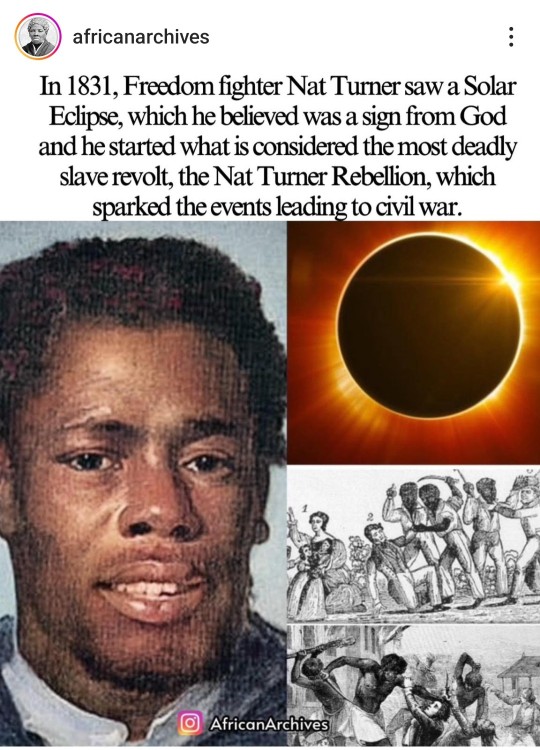
Around early 1828, Nat Turner was convinced that he "was ordained for some great purpose in the hands of the Almighty". A solar eclipse and an unusual atmospheric event and is what inspired Nat Turner to start his insurrection, which began on August 21, 1831. Nat Turner believed God was showing him a sign by putting a black man hand over the Sun. Its been known for thousands of years solar eclipse give off energy. On August 21, he began the rebellion with a few trusted fellow enslaved men. The rebels traveled from house to house, freeing enslaved people and killing their White owners. Turner's rebellion was suppressed within two days and he was captured October 30. On November 5, he was convicted and sentenced to death and was hanged November 11, 1831. The state executed 56 other Black men suspected of being involved in the uprising and another 200 Black people, most of whom had nothing to do with the uprising, were beaten, tortured, and murdered by angry White mobs. The Virginia General Assembly passed new laws making it unlawful to teach enslaved or free Black or Mulatto (mixed) people to read or write and restricting Black people from holding religious meetings without the presence of a licensed White minister.
#Nat Turner#solar eclipse#insurrection#rebellion#enslaved people#White owners#suppression#capture#conviction#death sentence#execution#Virginia General Assembly#laws#literacy#religious gatherings#racial oppression
59 notes
·
View notes
Text

Bill of Sale for Person Named George
Record Group 21: Records of District Courts of the United States Series: Law, Equity, and Criminal Case Files
Know all men by these presents, That I, Albert G. Ewing of the county of Davidson and the state of Tennessee have this day, for and in consideration of five hundred dollars, to me in hand paid by Joseph Woods and John Stacker, Trustees for Samuel Vanleer, his wife and children, under the will of Bernard Vanleer, now recorded in the office of the Davidson county court, state of Tennessee, bargained and sold unto said Trustees, a certain negro boy named George aged about seventeen years; which said slave I warrant to be sound and healthy; and I also will warrant the right and title of said slave, unto said Trustees, their heirs, executors, &c &c. and that said negro boy George is a slave for life. Witness my hand and seal, this sixth day of November 1833. Frederick Bradford Nov. 6. 1833. A.G. Ewing Orville Ewing
34 notes
·
View notes
Photo
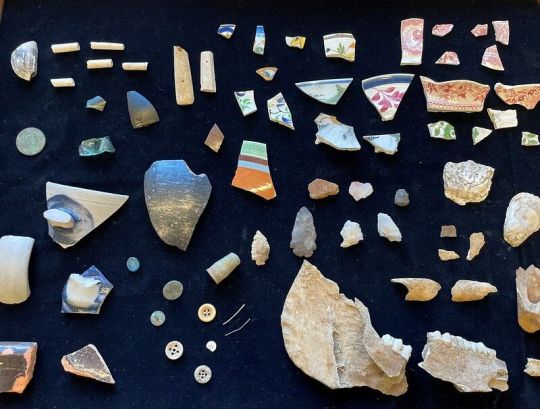
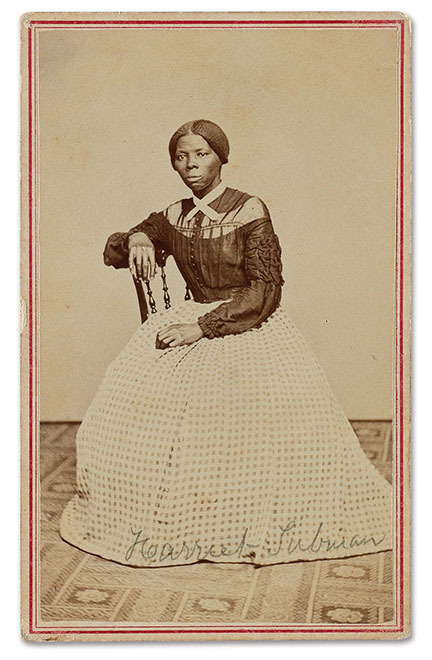
The governor’s office said the home is believed to be that of an enslaved overseer, possibly Jerry Manokey. It follows the April 2021 announcement of the discovery of the home of Ben Ross, Tubman’s father.
“Harriet Tubman’s birthplace is sacred ground, and this discovery is part of our ongoing commitment to preserve the legacy of those who lived here,” Moore said in a news release.
Maryland Department of Transportation Chief Archaeologist Dr. Julie Schablitsky and her team have been searching for the homes of those enslaved on the Thompson Farm for more than two years. At one time, more than 40 enslaved people lived there. The recent home discovery is on private property, while the archaeological remains of Ross’s home are located on the Blackwater National Wildlife Refuge.
Beneath layers of soil, archaeologists uncovered a substantial brick building foundation of the home. The excavation also revealed hundreds of artifacts.
Watch interview with archaeologist Dr. Julie Schablitsky here.
Source: AP News, WBALTV, Town & Country Magazine. Learn more about the rare Harriet Tubman photo used above here.
Visit www.attawellsummer.com/forthosebefore to learn more about Black history and read new blog posts first.
Need a freelance graphic designer or illustrator? Send me an email.
#Blackwater National Wildlife Refuge#Ben Ross#Thompson Farm#Harriet Tubman#archaeology#enslaved people#slaves#slavery#New England#Maryland#Baltimore Maryland#Baltimore history#Black history#American history#Dorchester County
10 notes
·
View notes
Text
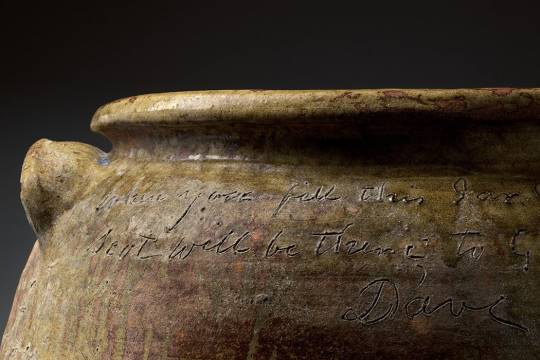
Most of the potters at this time, those who were enslaved as well as the white laborers who were not, did not inscribe or mark their work in any identifying way. Dave was different. He signed his name on the walls of his pots. He engraved markings, for example, such as forward slashes and circled X’s that may have been a way to keep inventory, or that hearkened to ancestral roots. Dave also wrote dates, the location where he fashioned the pots, lines of poetry, and Christian proverbs. All of these practices set him apart."
"Such men were true artists in a world that did not recognize their work, yet they persisted in moving beyond necessity to create works of enduring beauty.”
Full Article On JStor.org
#art history#pottery#ceramics#dave the potter#enslaved people#Southeast US#the South#South Carolina#handmade#art#sculpture
2 notes
·
View notes
Link
3 notes
·
View notes
Text
White Supremacy vs. Black Legacy
Drinking coffee while walking down the street. The thoughts came as I listened to the podcast Kelechi Okofor’s Say Your Mind. I stood in the cold and wrote… The fact that enslaved people were repositioned to work as internships apprenticeships etc after the abolishment of slavery with the slaved families getting compensation for their black bodies nullifies the act and undermines the totality…

View On WordPress
2 notes
·
View notes
Text
Your STUNNING Destination Wedding on a South African Slave-Worked Vineyard
AKA THIS HAPPENS HERE TOO



The Western Cape was the only region in South Africa that had enslaved people shipped in (from the Dutch East) auctioned, bought for plantation work. The enslaved people worked the huge picturesque vineyards and fruit farms of the region. The wineries are still there, people love holidaying at them, getting married at them.
The group of folks descended from the slaves still have massive socio economic set backs, the poorest indicators of any demographic in the country in certain areas (health, education, employment). One of the ways they were enslaved was through a system of addiction (called the Dop or Tot system), where they were fed alcohol rations every work day. The children of the enslaved people also began working very very young and were also fed alcohol rations. To this day, this population has one of the highest rates of fetal (foetal) alcohol syndrome (FAS/FASD) in the world.
One of the vineyards forces you to hear about the enslaved population who worked it. You go for a wine tasting and they have a descendent from that very population talk you through your wines and your history, it also has a free museum dedicated to their lives and work, and splits its profits to go to a fund for supporting the population breaking the cycle of poverty. Despite being a small label, it persuaded (and shamed?) other wineries into contributing to the fund. But yeah, a lot of people don’t like showing up for a wine tasting only to have it come with an info session on slavery in the wine region. That little winery has just been bought by some Americans but they seem dedicated to keeping the community enrichment and museum going. At least, they’re saying the right things, for now. I am hopeful.
But yeah, white South Africans and white foreigners looooove getting hitched at these sites of incredible human misery and subjugation. To be fair, this is not super common information in South Africa, especially outside of the region. I hope that many of the people simply don’t know that these places were, essentially, slave plantations.
Quick basic links:
btw its actually crazy that plantation tours are a thing that exist in the u.s. and that theyre not all set up like memorials similar to concentration camp museums like how is this marketed as a chill tourist activity or wedding destination and not extremely disturbing and depressing to see. worthless country
#history#slavery#south african history#southern african slave markets#South African cape colonies#slave trade#enslaved people#the dop system#fetal alcohol syndrome#foetal alcohol syndrome#destination wedding#vineyard weddings#plantation weddings#Western Cape#South Africa#South African fruit#South African wine#solms-delta#breede valley#franschhoek#stellenbosch#paarl#ceres#colonialism#colonial violence
32K notes
·
View notes
Text
youtube
#american history is truly disgusting#slavery#enslaved people#african american history#american history#god i'm feeling sick#Youtube
1 note
·
View note
Text
just a friendly reminder that, just because slavery was formally "abolished" in the so-called united states* in 1865, enslavement itself is still ongoing in the form of incarceration, which disproportionately affects Black and Indigenous people

(*i say "so-called" because the US is a settler-colonial construction founded on greed, extraction, and white supremacy) recommended readings/resources:
The New Jim Crow: Mass Incarceration in the Age of Colorblindness by Michelle Alexander
"How the 13th Amendment Kept Slavery Alive: Perspectives From the Prison Where Slavery Never Ended" by Daniele Selby
"So You're Thinking About Becoming an Abolitionist" by Mariame Kaba
"The Case for Prison Abolition: Ruth Wilson Gilmore on COVID-19, Racial Capitalism & Decarceration" from Democracy Now! [VIDEO]
#i know most of u probably followed me for fandom stuff but abolition and decolonization and sex workers' rights are so close to my heart#normally i'd post this on my academia blog but i have more followers here so. here ya go#enslavement is still ongoing in SO many other ways and it disproportionately targets BIPOC and disabled and impoverished people#might make another post about that#prison abolition#abolition#racial justice#juneteenth#social justice#human rights#resources#police abolition#decolonization#michelle alexander#mariame kaba#ruth wilson gilmore#13th amendment#antiracism
9K notes
·
View notes
Text
American President Abraham Lincoln issued the Emancipation Proclamation. January 1, 1863.
Image: First Reading of the Emancipation Proclamation of President Lincoln by Francis Bicknell Carpenter (1864) (Public Domain) On this day in history, January 1, 1863, as the third year of the Civil War approached and the carnage on the battlefield continued, American President Abraham Lincoln issued the Emancipation Proclamation. The Proclamation pronounced “that all persons held as slaves”…
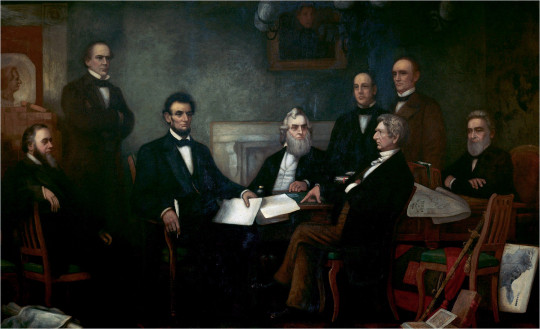
View On WordPress
0 notes
Text
John Edmonstone, the formerly enslaved person who became a master taxidermist and taught Charles Darwin at university in Scotland
This piece also gives a good description of the incredibly complicated relationships that developed between enslaved people and the people who enslaved them.
0 notes
Text
Truth.

#immigration#enslaved people#racism#vote#harris walz 2024#vote harris#vote democrat#kamala harris#kamala 2024
100 notes
·
View notes
Text
Women pioneers of reparations
I’ve previously posted about Henrietta Wood. Here are some other early women pioneers for reparations.
Belinda Sutton
Belinda (Royal) Sutton was born in 1712 in Ghana. She was abandoned by her enslaver, who had offered emancipation upon his death or her transfer to his daughter. If she chose freedom he provided 30 pounds for three years so she wouldn’t be a public charge. In 1783, at 63 years old, Sutton filed a petition to the Massachusetts General Court requesting a pension from the estate of her former enslaver. In her petition she recalled her life in Africa as a joyful one full of love prior to her captivity and enslavement. Sutton’s testimony describing the happy times with family in Africa contradicted the narrative that the enslaved were happy in their captivity. She won her claim and was awarded 15 pounds and 12 shillings annually. She had to fight continuously for that award to be honored and paid.
Belinda Sutton’s […] petition of 1783 is among the earliest narratives by an African American woman. […] It has been seen by some commentators as the first call for reparations for American slavery [and] opens a rare window onto the life on an enslaved woman in colonial North America.
To read the full text of Belinda Sutton’s first petition, click here. All of her petitions are available through the Antislavery Petitions Massachusetts Dataverse, maintained by Harvard University.
Callie House
Callie House was born enslaved in Rutherford County, Tennessee, in 1861. In 1897, at 36 years old, she founded the National Ex-Slave Mutual Bounty and Pension Association (MB&PA) to seek financial support for former slaves left without resources. With Isiah Dickerson she traveled to former slave states to encourage others to join the organization. The organization was eager to petition Congress for a bill that would grant payments (reparations) and mutual aid for burial expenses. Their grass-roots advocacy grew in membership to hundreds of thousands of formerly enslaved residents all over the country. The government used three agencies to try to stop this movement: the Federal Bureau of Pensions, the Department of Justice and the Post Office Department. On September 1899, the Post Office issued a fraud order, without evidence, against MB&PA, which made it illegal for them to send mail, cash or money orders. House resisted by invoking the 1st, 14th and 15th amendments and hiring an attorney.
Congress rejected the pensions petition, as if it was not to be taken seriously, and postponed it indefinitely.
In 1909, when Dickerson died, House became the leader of the MB&PA. In 1915, under House’s leadership, the class action lawsuit Johnson v McAdoo was filed in U.S. Federal Court requesting reparations for slavery in the amount of $68 million. This amount was cotton tax money collected from 1862 to 1868 and held by the U.S. Treasury Department. A former slave, H. N. Johnson, led the charge as the plaintiff against U.S. Secretary of the Treasury William G. McAdoo. The U.S. Supreme Court denied the claim. This was the first documented litigation for reparations for American chattel slavery in a U.S. federal court.
The following year, House was arrested on charges of fraud from the Post Office, convicted by an all-white, all-male jury and sentenced to a year in jail, deliberately hampering the reparations movement.
Callie House died from cancer in Nashville, Tennessee on June 6, 1928, at the age of 67. Source: Greenbelt News Review, BlackPast.org, RoyallHouse.org
Visit www.attawellsummer.com/forthosebefore to learn more about Black history and read new blog posts first.
Need a freelance graphic designer or illustrator? Send me an email.
#Callie House#Henrietta Wood#National Ex-Slave Mutual Bounty and Pension Association#reparations#enslaved people#slavery#lawsuit#American history#black histoy#Belinda Sutton#Tennessee history#Massachusetts history
0 notes